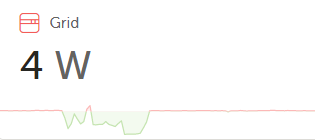When a large essential load is switched off… I get a large negative flow amount back to the grid?
Please explain. I thought the Carlo would make sure this does not happen.
G
When a large essential load is switched off… I get a large negative flow amount back to the grid?
Please explain. I thought the Carlo would make sure this does not happen.
G
Carlo does nothing bar measuring what goes past/comes in at THAT point.
When big loads go off, feedback is 100% guaranteed and perfectly normal.
A host of things, software, and hardware, need to work in tandem to mitigate the effect.
If you want to see how rough it gets, sit and watch when an induction plate/MW/air fryer is working for a few minutes. Especially when they are on temp. ![]()
Thousand or more watts can be sent back for a few seconds every few cycles.
The system is SLOWER with the external energy meter. It takes up to 15 seconds to pull back fully after a large load switches off. With the faster EM540 meter, it is around 3 seconds.
Unless you have an energy meter that trips because of that, I would simply not worry about it.
I wonder if an EM540 would have been a better choice for a system I keep an eye on. It pretty much has to run on a grid set point of 150 watts in order not to trip the Conlog. This has been fine for almost 2 years (150 watts) but if a heavy load switches on the non essential side it needs a minimum 500 watt set point. I installed a switch on the neutral line to the Carlo and they just flick that off when using the oven which is the main culprit. The oven is rarely used but the user needed a very simple to remember procedure when using the oven. Switching Carlo off puts the system into bypass. Two years importing 150 watts 24/7 on a system that gets through the night without grid does add up to well over R2k/year.
I cannot make any guarantees, but what I can tell you, is that with a faster meter the control loop has a dynamic “alpha” factor that determines how much of the error is mixed in on each adjustment iteration (roughly twice a second, which is about the fastest you can get a power reading out of the Multi).
If it is far away from the target power level, it will feed in up to 110% of the error between the current power and the desired power, which causes a very sharp pullback that sometimes even overshoots a little, but is generally caught and smoothed out as it approaches the correct power value.
This will help, but that conlog trips on 600 Joules… there is no single solution that is going to solve that completely.
Thanks for the interesting feedback, I was just thinking out loud. Once the SSEG is submitted/approved a bi-directional meter will be fitted and the import via Setpoint will cease and generate some earnings from export. Export wasn’t the aim of this system but the resident is happy to pay for a hands off system that doesn’t demand close monitoring. No alternative meter/setting solutions are offered by that municipality.
Finally had a bi-directional meter installed at a site where I assist a friend and the system is now operating as advertised. No more 150w import setpoint 24/7 and 500w setpoint when using the oven. (oven thermostat tripping the Conlog) Cost of the meter install in Langebaan was R8900
